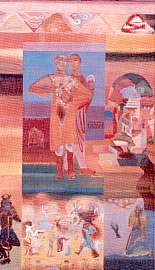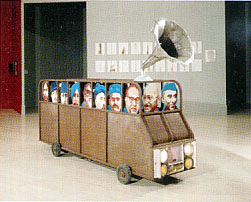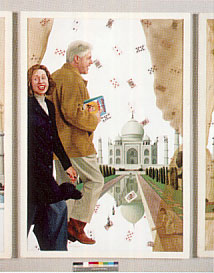Edge of Desire: Recent Art in
India
Mumbai:
January 8th - February 7th, 2007
The National Gallery of
Modern Art (NGMA) and Asia Society India
Centre present a major international
exhibition of contemporary Indian art, a
decade long perspective on visual practices
in India., Co-organized by Asia Society and
the Art Gallery of Western Australia, Edge
of Desire: Recent Art in India includes 80
works of sculpture, painting, drawing,
installation, video and interactive media
from 1993 to the present. Curated by
Chaitanya Sambrani (Australian National
University, Canberra), Edge of Desire
"reflects contemporary Indian society's
constantly shifting experiences of caste
alliances, class structures, and global
trends in localised settings," notes Asia
Society President Vishakha N. Desai, |
|

View Exhibition |
|
| |
|
|
Professor
Rajeev Lochan, Director, National Gallery of
Modern An s "In recent years, Indian
contemporary an has found its due recognition on
the international stage. By bringing this highly
acclaimed, cutting edge exhibition to India, the
NGMA hopes [o facilitate a meaningful engagement
between artists and their works, to understand
how the art resonates in its own
environment."
The
34 artists and two collectives represented in
this exhibition conicme from all around India,
from the metropolises of Delhi and Mumbai to the
rural regions of Kondagaon and Midnapur,
embodying a wide range of generational and
social contexts. The works of art include large
installations and intimate drawings, and
encompass a variety of visual cultures,
traversing the conventional divides of urban and
rural, fine and folk art,. and high and popular
culture.
"Edge
of Desire is a signature art event that marks
the opening of the Asia Society India Centre.
The exhibition is first in a series of international
art and cultural events 'hat we will bring to
audiences in South Asia', says Bunty Chand.
Executive Director, Asia Society India Centre.
In the past two years this exhibition has travelled to
various locations in Australia, the United States, and
Mexico. The show, culminating in its home country, is
a continuing dialogue with the society, people and
culture that have inspired the art and its makers. |
|

Nilma Sheikh, Firdaus II:
Every Night Put Kashmir in your Dreams,
2003-2004
|
The Works
|
The
selection of works explores the role of place
and desire in the creation of visual art in
contemporary India, at a time defined by
economic globalization and political
fundamentalism. The exhibition investigates the
impact of these germinal forces on the work of a
diverse group of artists who represent different
generations, regions, and social contexts. Their
work spans several professional, material, and
disciplinary boundaries, extending across urban,
gallery-based practice and Adivasi (The tribal
peoples of India), folk, and popular visual
cultures. There are clearly discernible links,
dialogues, and arguments across this spectrum.
The exhibition contributes to a contemporary
understanding of the diversity of visual culture
in contemporary India.
Nilima
Sheikh's series of painted scrolls (2003-04) made
specifically for this exhibition, reference several
centuries of writing inspired by Kashmir in an
extended meditation on desire and loss. |
|

Nataraj Sharma, Freedom Bus
(Or a View from the 6 th Standard), 2001-2004
|
Swarna and Manu Chitrakar arc members of a community
of patua (scroll-maker) painter-performers from West
Bengal (the surname Chitrakar, meaning painter, is a
trade name thai all painters from this community use).
Though [heir work tends to be characterized as folk
art - implying works that arc decorative, even naive
and static in process—Manu and Swarna draw on their
traditions and skills to articulate responses to
contemporary life and events, as evidenced in Swarna's
scroll Titanic (2003) based on the eponymous 2001 film
and Mann's scroll Afghanistan War (2003),
|
Some
of the works in the exhibition are concerned
with the artists' relationships with the many
guises of popular culture in contemporary India:
the visual culture of television, advertising,
cinema and Bollywood, and the unruly, mixed-up
visions characterized by everyday life on the
street. Atul Dodiya's triptych, Tomb's Day
(2001) makes parodic references to one of
India's stereotypical icons, the Taj Mahal.
Executed in the visual style of billboard
painting, the work is in pad an ironic
commentary on the media furor surrounding the
visits to India by Presidents Clinton and Putin.
Certain works also examine migration and
transience as major features of the contemporary
Indian experience. Works included under this
theme range from personal histories and realist
commentaries to Fabrications of
self-transformation. Subodh Gupta's
self-portrait, Bihari (1999) is a wry commentary
on the ' artist's migration from his native
Bihar to upwardly mobile Gurgaon, in Delhi. In
this work he uses cow dung to cover the painting
with an LED spelling out Bi-ha-ri, a person from
Bihar but also a derogatory term in India,
implying uncouth ness |
|

Atul Dodiya, Tomb's Day, 2001
|
A
series of works (2003) by the painter Santosh Kumar
Das responds to communal violence in Gujarat,
referencing a figurative tradition of Madhubani
painting of juxtaposing recent events with historical
figures such as Mahatma Gandhi.
|
The
exhibition also encompasses works that conflate
regenerating materials and renewal of tradition,
and that are playful, often satirizing popular
consumer culture. Sharmila Samant's work, A
Handmade Saree (1998)3 is painstakingly crafted
from 1,800 Coca-Cola bottle caps fastened
together with steel shackles. Draped as in a
boutique display, it reveals traditional textile
patterns such as mango motifs. On the floor,
three framed texts provide the formal meanings
of the terms "handmade." "saree"
and "coke."
Another
exhibition highlight is L.N. Tallur's large
scale and brightly colored, inflatable vinyl
installation Made in England; A temple designed
for India (2000), which addresses the mania for
shrines and the search for spiritual mots.
Viewers can enter the darkened sanctum of this
easily transportable temple. of
the participating artists—who represent three
generations— some are internationally recognized,
some are well-established and some are among the
country's most innovative, emerging artists. They
include: Ganga Devi Bhatt, Manu Chitrakar, Swarna
Chitrakar, Santosh Kumar Das, Atul Dodiya, Shilpa
Gupta, Subodh Gupta. Archana Hande, N..S. Harsha,
Rummana Hussain, Tushar Joag. |
|

Subodh Gupta, Bihari, 1999
|
Ranbir Kaleka, Ravi Kashi, Mallikarjun
Katakol, Sonia Khurana, Raj Kumar Koram, Umesh
Maddanahalli, Nalini Malani, Kausik Mukhopadhyay, Pushpamala N.
and Clare Arni. Open
Circle, Cyrus Oshidar/MTV India, Raqs Media
Collective, N.N. Rimzon. Sharmila Samant, Nataraj
Sharma, Gulammohammed Sheikh, Nilima Sheikh, Dayanita
Singh, KG. Subramanyan, Vivan Sundaram, L.N. Tallur,
Vasudha Thozhur, Sonadhar Vishwakarma, and Subhash
Singh Vyam.
|
Related
Education and Outreach Programmes:
The NGMA and Asia Society India Centre have
organized various educational and outreach
programmes. This includes a half-day artist
symposium, daily guided tours, film screenings,
artist-led gallery walks, artist-led workshops
for college students and programmes for women,
senior citizens and children with disabilities.
|
|





